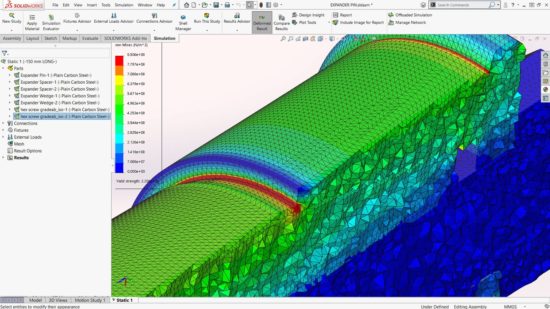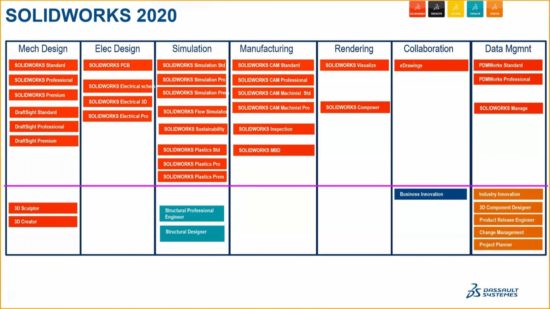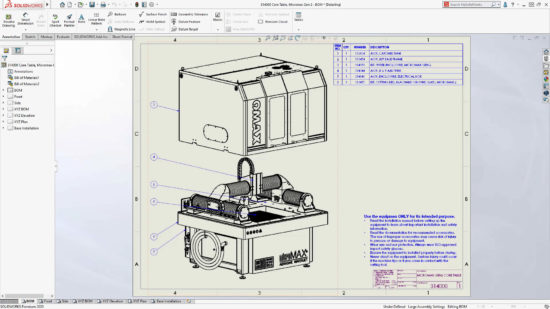Are the dominos tipping in favor of the cloud?
What a company says about its strategy and its attitude towards its customers is always important. SolidWorks says every new release is built around customer requests. With the release of SolidWorks 2020, the company’s PR says, it has dealt with “thousands of enhancement requests.” But, just as important, this new release is also “seamlessly connecting” to the 3DExperience platform meaning that new features are based on a different technology platform than the SolidWorks core technology. This isn’t exactly a demand from the customers’ base, but they’re getting used to the idea, says SolidWorks executives.
Dassault is determined to get all its customers on the same platform, 3DExperience, because tools can be more interchangeable and the data flows more easily across components. It will all be cloud enabled. Dassault is not selling CAD tools, it’s selling an ecosystem.
The writing on the wall was apparent at SolidWorks World 2019, which, as it turns out was the last SolidWorks World. From now on it will be 3DExperience World and it’s coming up in February 2020 in Nashville, Tennesee.
The benefit, says SolidWorks CEO Gian Paolo Bassi, is that it offers integration and collaboration. “This gives organizations the environment and the applications to truly embrace the Industry Renaissance and its spirit of discovery for new ways of inventing, innovating, collaborating, and producing,” he says in a prepared quote.
This version of SolidWorks is going to go down as the transitional version. The emphasis in 2020 is on 3DExperience features that make collaboration and communication easier. The headline features for SolidWorks 2020 core are weighted towards performance and efficiency. Ironically, one of the hottest new features is probably the detailing mode, which snappily opens views with none of the heavy 3D baggage that underpins that view allowing users to add annotation, dimensions, perform minor edits, etc. It eliminates the too many minutes it may take to open a large assembly and the too many seconds it takes to update the view as changes are made. Users are swooning or would if most of them weren’t engineers. It’s a reminder that drawings, even if digital drawings, are intrinsic to the CAD workflow.
The attached grid lays out the different components of SolidWorks and what package includes them. The entries below the line are updates for 2020 and it’s especially significant that the features in teal and orange are benefits flowing from Simulia (teal) and Enovia (orange). SolidWorks features are in red. The key at the top of the grid shows where the new features are coming from.

SolidWorks highlights the new features in 2020 this way:
- Detailing mode: enables users to open their drawing immediately without loading the entire model. It allows users to add and edit annotations.
- Make Part Flexible: enables users to display a flexible part such as a spring, bellows, hinge, o-rings, etc., in different states. Say, compressed, expanded, in a neutral state. This is useful for people who are working with these kinds of components to see how it will work, but they don’t have to actually simulate the movement. They can just see how it looks.
- Large Design Review gives users fast access to large models quickly with a lightweight graphical view. It’s not a brand new feature, but it’s been improved with new features, such as the ability to create mates to the reference geometry of components, create and edit linear and circular component patterns, edit pattern-driven and sketch-driven component patterns.
- The new version also has improvements to sketching that make the process faster. New tools enable G3 curves and in addition to more levels of undos. This is another big-little thing. The added redos mean that when over enthusiastic back-tracking doesn’t result in lost work.
- New tools for working with meshes make it easier to scan objects and bring them into SolidWorks.
- Improved surfacing capabilities.
- 3D Interconnect, the ability to use models from outside sources, meaning non-SolidWorks data has been improved with support for DWG, DXF, and IFC.

And there is considerably more but as mentioned at the start, the real message of 2020 is all the benefit SolidWorks users can realize from Dassault’s 3DExperience platform and the cloud. Dassault has been building a set of new design tools around SolidWorks using technology from 3DExperience. 3D Sculptor is a set of new tools that redefine the process of modeling. It includes xShape (sub division modeling), and 3D Creator with new parametric modeling tools, data management, analysis tools for structures, and more. Dassault is inviting users to move to 3DExperience on their own terms by adopting 3DExperience.Works tools like 3D Sculptor and 3D Creator in their own time.
Will SolidWorks users go for it? Dassault has been introducing these new capabilities carefully and they’re not taking anything away from customers. Although Dassault is offering some advanced capabilities, the parallel development is far from done. People will continue to use SolidWorks and, Dassault hopes, adopt 3DExperience.Works components as they become available.
What do we think?
This is a process that’s already taken most of a decade as Dassault tries to get its user base on a common platform. There have been plenty of people who have predicted the end of SolidWorks as a result of Dassault’s ambitions, but the users have remained loyal to their preferred software and Dassault has been very careful to bring their customers along gradually. They really are carefully listening to their customers or this wouldn’t work at all.
The same process has an analog in Dassault’s high end. For more than a decade, the company has been transitioning its customers to a new platform, V6, which was introduced in 2008. It is now 3DExperience (not to be confused with the bridge technology 3DExperience.Works for SolidWorks users). The transition has been excruciatingly slow and the company has lost some customers along the way, but its revenues have steadily grown. In 2016, analyst Monica Schnitger commented on Dassault’s progress. The company announced it was making good progress when it had reached 36% of users making the transition. Dassault is a very patient company. It expects to win SolidWorks over to the 3DExperience platform in the same gradual way.
For a more technical look at SolidWorks 2020:
https://blogs.solidworks.com/solidworksblog/2019/02/technology-preview-solidworks-2020.html





